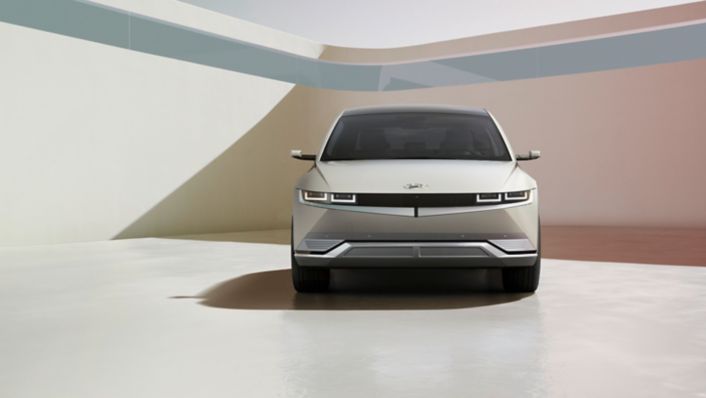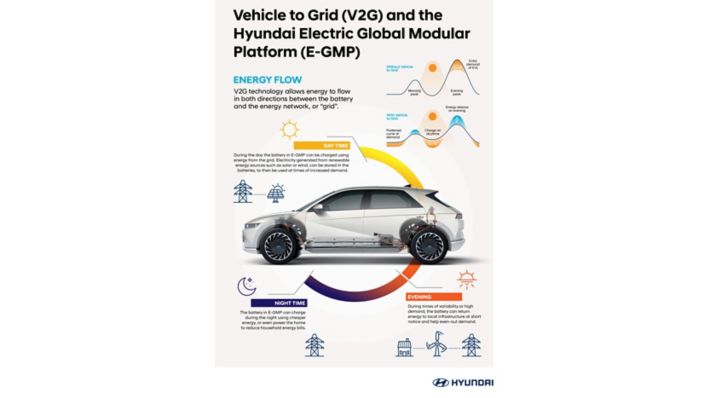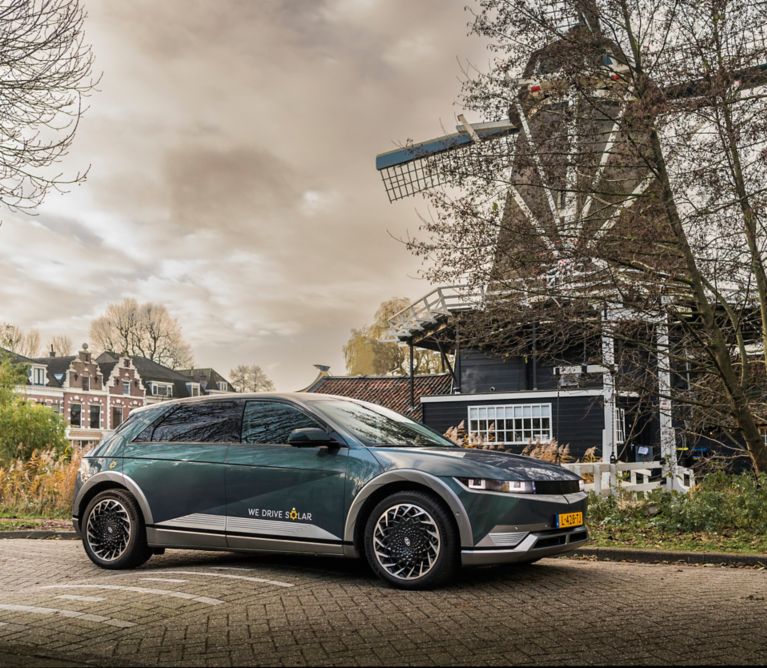- Hyundai Motor is developing Vehicle-to-Everything (V2X) technology to further develop the usability of renewable energy sources and reduce strain on local electricity networks
- Vehicle-to-Grid results in balanced energy grid, operational cost savings, and reduced fossil fuel dependency
- Company has two V2X pilot projects running in the Netherlands and Germany that feature IONIQ 5
Press material
-
Download
-
Images
Hyundai Motor is expanding its offer of energy solutions by developing Vehicle-to-Everything (V2X) technology. V2X is a technological innovation that further integrates renewable energy and battery electric vehicles (BEV) into society.
One of these technologies is Vehicle-to-Grid (V2G). This technology enables energy that is already stored in the battery packs of BEVs to be provided to an electricity network, also known as a ‘grid’. On top of stabilising the grid, the energy stored in BEVs feeds the grid to assist in managing energy demand during peak times and emergencies. Hyundai is currently running two V2X pilot projects in the Netherlands and Germany featuring fleets of modified IONIQ 5 models that are equipped with customised V2G-capable software.

The energy landscape will drastically change due to this integration of BEVs into the grid. Not only will BEV owners have the opportunity to contribute actively towards the stabilisation of their local grid, but V2G will also be a strong contributor to a stabilised renewable energy provision. The grid directly distributes renewable energy from solar or wind power to users. With the application of V2G, renewable energy can be stored in BEVs and fed back to the grid when it cannot be generated, for example at night or when there is no wind, or at peak times.
As V2G technologies benefit not only BEV owners but also entire societies sharing an energy system, this initiative falls in line with Hyundai’s “Progress for Humanity” vision.

V2G to better manage energy demands
To be able to support V2G, BEVs must be equipped with the correct hardware, including a bidirectional onboard charger that allows energy to flow to and from the battery pack, and appropriate software that controls this discharge.
This bidirectional energy transfer promotes more active electricity consumption as BEVs can still serve a purpose outside of passenger transportation. Since only a certain percentage of battery capacity is utilised for driving purposes, the remaining stored energy can be fed back to the grid to be used by local energy distribution utilities.
As countries are adding more variety to their energy mix to include more renewable energy sources, V2G technology will help reduce the impact of climate change. Instead of relying on reserve power plants, which generate more air pollution, the grid can depend on the energy stored in BEV battery packs generated from solar or wind power.
The benefits of V2G
As a convenient and cost-efficient way to locally store and share energy, V2G offers numerous benefits for BEV owners, the grid, and the environment.
When V2G technology balances the grid, everyone benefits. During high-peak times when large amounts of energy are drawn from the grid, BEVs can return energy to the local infrastructure and help even out the demand. Owners can then recharge their BEVs at a lower cost during off-peak hours.
According to business models that are currently under review, users can provide energy from their BEVs into the grid. Because grid services are used more efficiently, V2G results in savings for operating electricity systems, which are then passed on to the user. Additionally, the entire system can reap economic benefits from these reduced power system costs because V2G offsets capital and operational costs.
The implementation of V2G technology also accelerates the decarbonisation of the power system. Electricity generated from renewable energy sources, such as solar or wind, can be stored in BEVs. Overall, this will reduce the amount of carbon dioxide emissions from the power system because it will lessen the dependence on fossil fuels.
Harnessing the power of V2X
However, BEVs are not limited to pushing energy to the grid; they can power homes and buildings as well. V2X is the umbrella term used to describe the additional value of BEVs during times of non-use, including V2G as well as other use cases.
In a closed electric ecosystem, separate from the grid, a BEV can power a home to not only reduce the household energy bill but also reduce demand on the local grid. This specific case is known as Vehicle-to-Home (V2H).
In Vehicle-to-Building (V2B), energy stored in BEVs can be used to power a building, e.g., an office building.
Hyundai enters the V2X ecosystem
At IAA Mobility 2021, Hyundai announced its commitment to achieving carbon neutrality in its products and global operations by 2045. By 2035, the company aims to have a fleet of entirely zero-emission vehicles in Europe. One pillar of the company’s strategy is developing cleaner energy solutions and technologies, including V2G.
Currently, Hyundai is conducting two V2X pilot projects with various industry stakeholders: in the Netherlands and Germany. The pilot projects encompass two use cases: V2G and V2H, respectively.
Hyundai will apply its V2G technology with the Dutch mobility operator We Drive Solar. This collaboration will allow the city of Utrecht to become the world’s first bidirectional city. Through the project, We Drive Solar will first provide a fleet of 25 IONIQ 5 for a car-sharing scheme that will serve residents of new housing developments.
The next step of the project will be to enable V2G technology. This technology will be tested in combination with the public charging solution developed by We Drive Solar.
The V2H pilot project in Germany is being undertaken by CRADLE Berlin, Hyundai Motor Company’s corporate venturing and open innovation business. Like the pilot project in Utrecht, this one also involves a dedicated IONIQ 5 fleet. These prototypes are outfitted with the same bidirectional onboard charger used in IONIQ 5 mass production vehicles. However, customised software was installed in the prototype models to enable V2G technology. Their ability to share energy with the home is being tested within a closed home energy system.
Hyundai’s future with V2G
Electric Global Modular Platform (E-GMP), Hyundai Motor Group’s first BEV dedicated platform, already features Vehicle-to-Load (V2L) technology, which allows bidirectional charging. It is planned for the bidirectional onboard charger that enables V2L to also support V2G in the future.
V2L and V2G have similar technical principles regarding reverse power transmission; however, the technologies utilise different software. Since V2G needs to provide the grid with energy, a communication protocol between the BEV and the grid must first be defined.
Developmental projects for V2G are currently in progress at Hyundai, and the company plans to announce an upcoming BEV model with V2G technology.
About We Drive Solar
Based in the Netherlands, We Drive Solar is a local leading mobility operator that integrates solutions for mobility and energy systems for the future. The company is currently building a new energy system with thousands of solar panels, as well as hundreds of electric cars and smart charging stations. All We Drive Solar cars run on locally generated solar energy from 25 school roofs. Its goal is to bring electric cars, energy generation, and liveable cities together for a sustainable future.
About CRADLE
Hyundai CRADLE (Centre for Robotic-Augmented Design in Living Experiences) is Hyundai Motor Company’s corporate venturing and open innovation business. It focuses on seed-to-growth investments in numerous fields, including artificial intelligence, robotics, mobility-as-a-service (MaaS), smart energy solutions, and smart cities. CRADLE has hubs in five major cities worldwide: Silicon Valley, Tel Aviv, Berlin, Seoul, and Beijing.
Disclaimer: Electricity consumption and emissions data
- Electricity consumption combined for the Hyundai IONIQ 5 58 kWh with 2WD in kWh/100 km: 16.7; CO2 emissions combined in g/km: 0 (WLTP)
- Electricity consumption combined for the Hyundai IONIQ 5 58 kWh with 4WD in kWh/100 km: 18.1; CO2 emissions combined in g/km: 0 (WLTP)
- Electricity consumption combined for the Hyundai IONIQ 5 72.6 kWh (19” alloy rims) with 2WD in kWh/100 km: 16.8; CO2 emissions combined in g/km: 0 (WLTP)
- Electricity consumption combined for the Hyundai IONIQ 5 72.6 kWh (20” alloy rims) with 2WD in kWh/100 km: 17.9; CO2 emissions combined in g/km: 0 (WLTP)
- Electricity consumption combined for the Hyundai IONIQ 5 72.6 kWh (19” alloy rims) with 4WD in kWh/100 km: 17.7; CO2 emissions combined in g/km: 0 (WLTP)
- Electricity consumption combined for the Hyundai IONIQ 5 72.6 kWh (20” alloy rims) with 4WD in kWh/100 km: 19.0; CO2 emissions combined in g/km: 0 (WLTP)
- IONIQ 5 with the 77.4 kWh battery is not currently available for sale in Europe. Electricity consumption and CO2 values for this model have not yet been determined.













